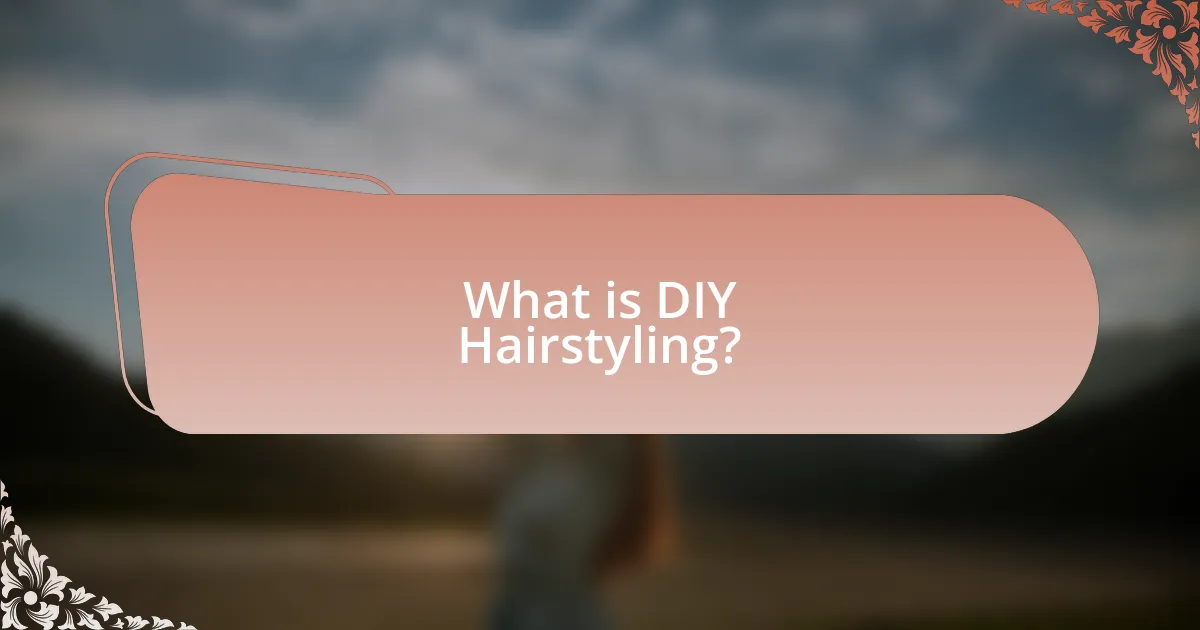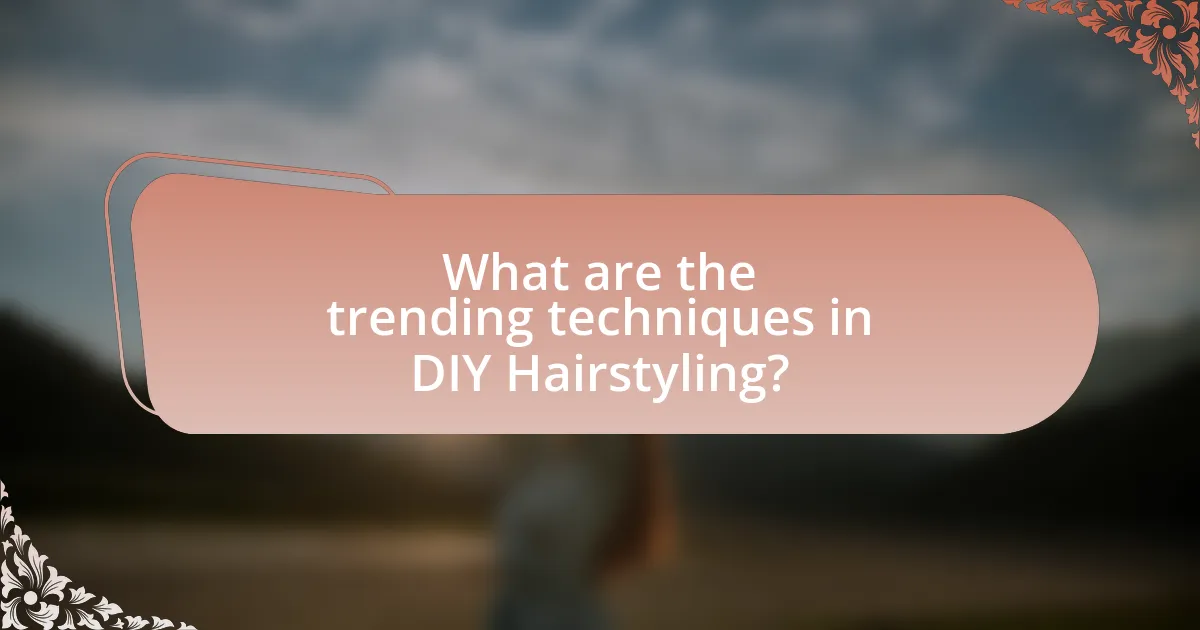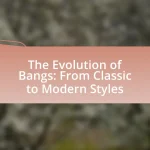DIY hairstyling refers to individuals styling their own hair at home using various techniques and tools, a practice that has gained popularity due to cost savings and the convenience of online tutorials. The article explores the evolution of DIY hairstyling, influenced by historical trends and cultural shifts, highlighting the growing desire for personalization and self-expression. It discusses trending techniques, essential tools, and common challenges faced in DIY hairstyling, while providing tips for achieving popular hairstyles and preventing damage. Additionally, it emphasizes the importance of staying updated on trends and utilizing available resources for learning new techniques.

What is DIY Hairstyling?
DIY hairstyling refers to the practice of individuals styling their own hair at home using various techniques and tools. This approach allows people to experiment with different hairstyles, cuts, and colors without the need for professional assistance. The rise of DIY hairstyling has been supported by the availability of online tutorials and resources, which provide step-by-step guidance for achieving salon-quality results at home. According to a survey by Statista, 45% of respondents in 2021 indicated they preferred DIY hair care due to cost savings and convenience.
How has DIY Hairstyling evolved over the years?
DIY hairstyling has evolved significantly over the years, transitioning from basic techniques to a diverse array of advanced methods facilitated by technology and social media. In the past, individuals primarily relied on traditional methods and limited resources, often using simple tools and techniques passed down through generations. However, with the rise of the internet and platforms like YouTube and Instagram, tutorials and innovative styles have become widely accessible, allowing users to experiment with complex hairstyles at home.
The introduction of specialized tools, such as curling wands, straighteners, and hair color kits, has further enhanced DIY hairstyling capabilities. According to a 2021 survey by Statista, 45% of respondents reported trying new hairstyles at home during the pandemic, indicating a surge in DIY hairstyling popularity. This evolution reflects a broader trend towards personalization and self-expression in beauty, empowering individuals to take control of their hair care and styling.
What historical trends have influenced modern DIY Hairstyling?
Historical trends that have influenced modern DIY hairstyling include the rise of counterculture movements, the democratization of beauty standards, and the impact of social media. Counterculture movements in the 1960s and 1970s, such as the hippie movement, encouraged self-expression through unconventional hairstyles, leading to a shift away from salon exclusivity. The democratization of beauty standards in the late 20th century, driven by the feminist movement, promoted the idea that individuals could style their hair at home without professional assistance. Additionally, the advent of social media platforms in the 21st century has facilitated the sharing of DIY hairstyling techniques, making tutorials and inspiration widely accessible, thus further popularizing at-home hairstyling practices.
How do cultural shifts impact DIY Hairstyling techniques?
Cultural shifts significantly influence DIY hairstyling techniques by altering societal norms, beauty standards, and access to information. For instance, the rise of social media platforms has democratized hairstyling knowledge, allowing individuals to share tutorials and techniques widely, which has led to increased experimentation with styles that were previously considered niche. According to a study by the Pew Research Center, 69% of adults in the U.S. use social media, which facilitates the rapid spread of new hairstyling trends and techniques. Additionally, cultural movements advocating for natural beauty and self-expression have encouraged people to embrace their unique hair textures and styles, further diversifying DIY hairstyling practices. This shift is evidenced by the growing popularity of natural hair care products and techniques, as reported by market research from Statista, which indicates a significant increase in sales of such products over the past decade.
Why is DIY Hairstyling becoming increasingly popular?
DIY hairstyling is becoming increasingly popular due to the growing desire for personalization and cost-effectiveness in hair care. Many individuals seek unique styles that reflect their personal identity, which DIY hairstyling allows them to achieve without relying on professional salons. Additionally, the average cost of salon services has risen, prompting consumers to explore at-home alternatives that can save money. According to a survey by Statista, 45% of respondents indicated they prefer DIY methods to save on expenses, further supporting the trend. The accessibility of online tutorials and social media platforms has also empowered individuals to learn and experiment with hairstyling techniques, contributing to the rise in DIY hairstyling popularity.
What are the cost benefits of DIY Hairstyling?
DIY hairstyling significantly reduces costs associated with professional salon services. By opting for at-home hairstyling, individuals can save an average of $50 to $100 per visit, depending on the complexity of the service. Additionally, purchasing basic hairstyling tools and products for DIY use often amounts to a one-time investment of around $100, which can be reused multiple times, further enhancing savings over time. This approach not only minimizes recurring expenses but also allows for personalized styling without the added costs of salon appointments.
How does DIY Hairstyling promote creativity and self-expression?
DIY hairstyling promotes creativity and self-expression by allowing individuals to experiment with various styles and techniques that reflect their personal identity. Engaging in DIY hairstyling encourages users to explore different colors, cuts, and textures, fostering a sense of ownership over their appearance. Studies show that personal grooming activities, including hairstyling, can enhance self-esteem and individuality, as individuals often feel more confident when they can express their unique style. This hands-on approach not only cultivates artistic skills but also empowers individuals to make bold choices that resonate with their personality, reinforcing the connection between self-image and creative expression.

What are the trending techniques in DIY Hairstyling?
The trending techniques in DIY hairstyling include the use of heatless curls, braiding methods, and the application of hair accessories for styling. Heatless curls, achieved through methods like twist and pin or using fabric strips, have gained popularity due to their ability to create waves without damaging hair with heat. Braiding techniques, such as the Dutch braid and fishtail braid, are favored for their versatility and ease of execution, allowing individuals to create intricate styles at home. Additionally, the use of accessories like headbands, clips, and scarves has become a trend, enhancing hairstyles while providing a quick and stylish solution. These techniques reflect a growing interest in maintaining hair health while achieving fashionable looks.
How can you achieve popular hairstyles at home?
To achieve popular hairstyles at home, you can utilize online tutorials and specific hair tools tailored for each style. For instance, using a curling wand can help create beachy waves, while a straightener can achieve sleek, straight looks. According to a survey by the Professional Beauty Association, 70% of individuals reported successfully replicating salon styles at home by following video guides. This demonstrates that with the right resources and tools, achieving trendy hairstyles is feasible for many.
What tools and products are essential for DIY hairstyling?
Essential tools and products for DIY hairstyling include scissors, a comb, hair clips, a hairdryer, styling products like mousse or gel, and heat styling tools such as curling irons or straighteners. Scissors are crucial for cutting and shaping hair, while a comb helps in detangling and sectioning. Hair clips are necessary for holding sections of hair in place during styling. A hairdryer is essential for drying and setting styles, and styling products provide hold and texture. Heat styling tools allow for versatile looks, enabling curls or straight styles. These tools and products are widely recognized in the hairstyling community for their effectiveness in achieving professional-looking results at home.
How do you select the right technique for your hair type?
To select the right technique for your hair type, first identify your hair’s texture, porosity, and density. For example, fine hair benefits from lightweight techniques like air-drying or loose waves, while thick hair may require more robust methods such as braiding or heat styling for definition. Understanding these characteristics allows for the application of suitable techniques that enhance your hair’s natural qualities. Research indicates that using the right styling method can significantly improve hair health and appearance, as noted in studies on hair care practices published in the Journal of Cosmetic Dermatology.
What are the most sought-after DIY Hairstyling techniques?
The most sought-after DIY hairstyling techniques include braiding, curling with a flat iron, and creating updos. Braiding techniques, such as fishtail and Dutch braids, are popular for their versatility and ease of execution. Curling with a flat iron allows for various curl styles, from loose waves to tight curls, making it a favored method among individuals seeking to enhance their hair texture. Updos, including messy buns and chignons, are frequently chosen for their elegance and suitability for various occasions. These techniques are widely shared on platforms like YouTube and Instagram, where tutorials demonstrate their effectiveness and accessibility for home use.
How do you create beach waves using DIY methods?
To create beach waves using DIY methods, you can use a simple technique involving braiding damp hair. Start by washing your hair and allowing it to air dry until it is slightly damp. Then, divide your hair into sections and braid each section tightly. Leave the braids in for several hours or overnight. Once you unbraid your hair, you will have natural-looking beach waves. This method is effective because braiding creates texture and wave patterns without the use of heat, reducing the risk of damage to your hair.
What steps are involved in achieving a perfect braid at home?
To achieve a perfect braid at home, follow these steps: First, gather your hair into a manageable section, ensuring it is clean and dry for optimal styling. Next, divide the hair into three equal strands. Begin braiding by crossing the right strand over the middle strand, then the left strand over the new middle strand. Continue this pattern, alternating sides until you reach the end of the hair. Secure the braid with a hair tie to maintain its shape. For added hold and polish, you can apply a light hairspray. This method is effective as it utilizes the basic three-strand technique, which is foundational in hairstyling and widely practiced for its simplicity and versatility.

What challenges might you face in DIY Hairstyling?
DIY hairstyling presents several challenges, including lack of experience, difficulty in achieving desired results, and potential damage to hair. Individuals often struggle with techniques such as cutting or coloring, which require precision and skill that may not be developed without professional training. For instance, a survey by the American Academy of Dermatology found that 40% of individuals who attempted at-home hair coloring experienced undesirable outcomes, such as uneven color or hair damage. Additionally, the absence of professional tools can lead to suboptimal results, further complicating the DIY process.
How can you troubleshoot common DIY Hairstyling issues?
To troubleshoot common DIY hairstyling issues, first identify the specific problem, such as frizz, uneven cuts, or color mishaps. For frizz, use a leave-in conditioner or anti-frizz serum to smooth hair and reduce flyaways. If the cut is uneven, use sharp hair scissors to trim small sections gradually until the desired length is achieved. For color mishaps, applying a clarifying shampoo can help remove excess dye, while a deep conditioning treatment can restore moisture. These solutions are effective as they directly address the root causes of common hairstyling problems, ensuring a more polished result.
What should you do if a hairstyle doesn’t turn out as expected?
If a hairstyle doesn’t turn out as expected, the first step is to assess the situation calmly. You can try adjusting the style with hair products like gel or mousse to reshape it. If the issue is severe, consider using hair accessories such as clips or headbands to conceal the problem. Additionally, you may opt for a temporary fix by tying the hair back or creating a bun. If the hairstyle is significantly unsatisfactory, visiting a professional stylist for correction is advisable, as they can provide expert solutions tailored to your hair type and desired look.
How can you prevent damage while experimenting with hairstyles?
To prevent damage while experimenting with hairstyles, use heat protectant products before applying any heat styling tools. Heat protectants create a barrier between your hair and the heat, reducing moisture loss and preventing structural damage. According to a study published in the Journal of Cosmetic Science, using a heat protectant can lower the risk of hair breakage by up to 50%. Additionally, limit the use of heat styling tools, opt for lower temperature settings, and incorporate regular deep conditioning treatments to maintain hair health.
What tips can enhance your DIY Hairstyling experience?
To enhance your DIY hairstyling experience, start by gathering all necessary tools and products before beginning. This preparation ensures efficiency and reduces frustration during the styling process. Additionally, watching tutorial videos specific to your desired hairstyle can provide visual guidance and techniques that improve your skills. Research indicates that visual learning can increase retention and understanding, making tutorials an effective resource. Lastly, practicing regularly allows you to refine your techniques and build confidence, as studies show that repeated practice leads to mastery in various skills, including hairstyling.
How can you stay updated on the latest DIY Hairstyling trends?
To stay updated on the latest DIY hairstyling trends, regularly follow beauty blogs, social media platforms, and YouTube channels dedicated to hairstyling. These sources often showcase current trends, tutorials, and expert tips. For instance, platforms like Instagram and TikTok feature influencers who frequently post about new techniques and styles, making them valuable resources for real-time updates. Additionally, subscribing to newsletters from reputable beauty websites can provide curated content on emerging trends and products.
What resources are available for learning new techniques?
Online platforms such as YouTube, Skillshare, and Udemy offer extensive resources for learning new hairstyling techniques. YouTube features countless tutorials from professional hairstylists and enthusiasts, providing visual guidance on trending styles. Skillshare and Udemy host structured courses that cover various hairstyling techniques, often taught by industry experts. According to a report by Statista, as of 2021, over 2 billion users accessed YouTube, highlighting its popularity as a learning tool. These platforms collectively provide a diverse range of instructional content, making them valuable resources for anyone looking to enhance their hairstyling skills at home.


